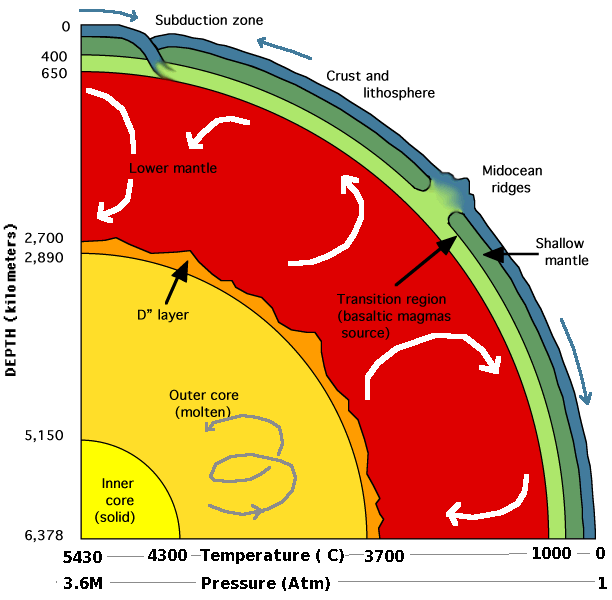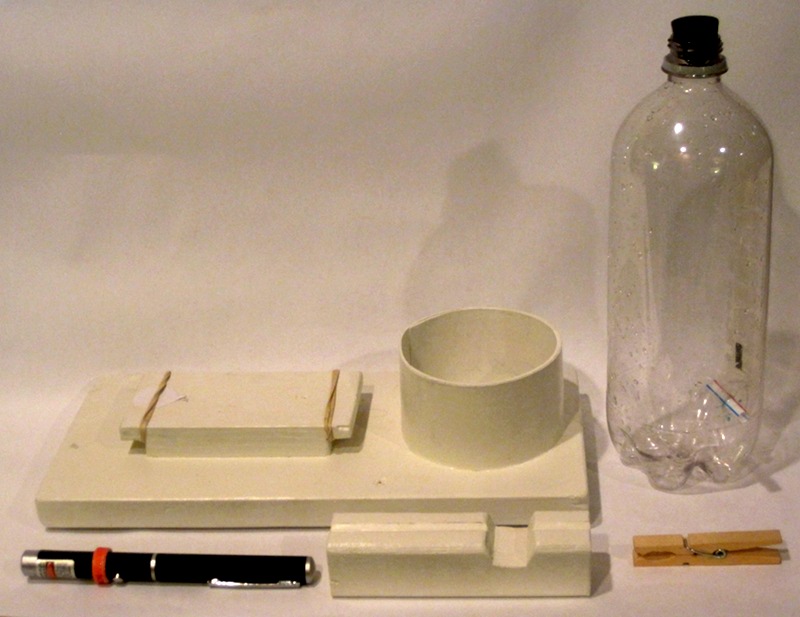 |
 | ||||||||||||
|
|||||||||||||

Making music
I was asked to do a science hour in a kindergarten class - normally I work in a 6th-grade class. I decided to do something with music, since I could involve the children. I made this instrument out of bottles. You can tune them by adding water, and talk about how big things make low notes and vice versa. I did some of that in class, with the participation of the kids. We played on the bottles and sang songs. I also brought a bunch of kazoos, and some Raffi music for a singalong. Twenty kindergartners with kazoos is something to experience. |
|||||||||||||

About the Earth's interior
(1) The Crust
This is the solid, rocky outer shell of the Earth. Compared to the
radius of the Earth (6400 km), the crust is quite thin, ranging from
20 km on the ocean floor to 120 km where there are massive mountain
ranges. The crust rides on the mantle, a thick layer of magma.
(2) Mantle
As the
magma of the mantle cools off in the vicinity of the crust, cooled magma sinks
down and hotter plumes of magma rise up. Pieces of the crust called
tectonic plates are pushed around by this slow movement of the
mantle. Where plates split apart, fresh magma wells up from below, making
new crust. Most of this happens under water along
oceanic ridges, but there
are places where this happens on land, such as on Iceland. When two plates
converge, different things can happen: one plate can slide under the other,
as is happening in California, where the plate forming the pacific ocean
bottom
is sliding under California
. On the other hand India is moving North and is
crashing into Southern China, and this collision is pushing up the
Tibetan plateau and the Himalayan mountains.
(3) Core
The core is mostly made of iron. Since iron is denser than (molten silicate)
rock,
it sank down to center early in the formation of the Earth. In the outer core
the iron is molten, but as you get close to the center, the pressure rises
so high that the iron atoms get squeezed in to a solid. The liquid iron in the
outer core also circulates, and since iron is a magnetic material, the magnetic
field and the iron flow interact in complicated ways. For one thing, the
magnetic north pole moves around quite a bit from year to year, and the
whole field reverses every 10000 years or so. Having a magnetic field is handy
when you need to use a compass, but the real benefit for our earth is that
the magnetic field extends far out in space, and acts as a shield to deflect
the solar wind -
a mighty blast of particles streaming out from the Sun
all the time. Without this protection, the solar wind would have gradually
blown away our atmosphere into space billions of years ago. Occasionally,
some of the solar wind particles overwhelm the magnetic defenses, and sneak
in along the magnetic field lines near the top and bottom of the globe.
Where they slam into the top of the atmosphere,
they make auroras, the
Northern (and Southern) lights.
The upshot is that the world as we know it owes much to what happens deep below our feet: plate tectonics, driven by the mantle, shapes all the lands and the oceans, and the magnetic field, driven by the core, protects us from nasty space weather.
Links:
|
|||||||||||||

Functions of the skin
[keep warm/cool, keep outside out, keep from drying, heat/cold/touch/pain/itch sensors, symbiosis with bacteria. Who has skin (endo/exo skeletons, terrestrial/aquatic), who has fur (heating/cooling). Functions of pigmentation, vit D, general benefits of sunlight. |
|||||||||||||
|
What is total internal reflection?
Links::
|
|||||||||||||
| |||||||||||||




